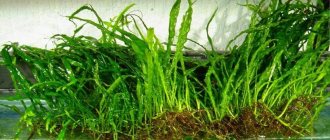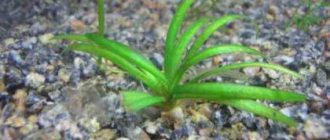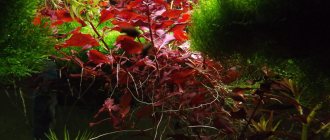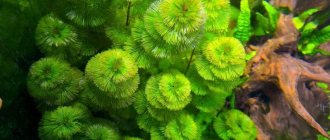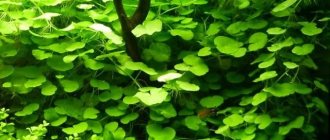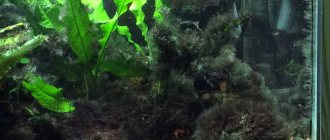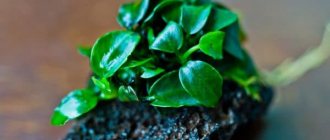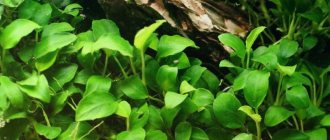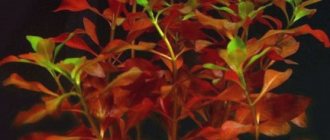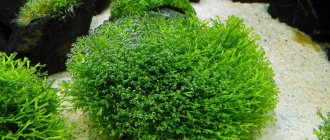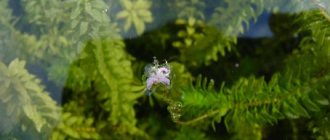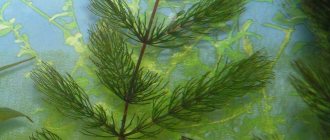4.3
(14)
When designing an aquarium, you definitely need to think about what plants will be in it. This is especially true in the first stages, when the balance has not yet been established, but you already want your home pond to look neat and well-groomed. Cirrus is perfect for such purposes. It grows quickly, creates large and dense thickets and does not require any special approach.
Maintenance and care in the aquarium
Despite the fact that the pinnate is a plant that is unpretentious in maintenance, you still need to take into account some recommendations in order to create good living conditions.
Water
For a full life, Urut needs neutral or slightly acidic water with a hardness of 6°. The water must be clean so that dirt particles do not interfere with the necessary absorption of nutrients, since in this case starvation occurs and the plant may even die.
It will be useful for you to read about how to properly change the water in an aquarium.
To keep the water clean for as long as possible, the aquarium must be equipped with powerful filters, and the water must be replaced partially, but every week. The optimal temperature, depending on the subspecies, is from +18 to +28 °C. Prolonged hypothermia is detrimental to water yarrow.
Lighting
To live fully, the cirrus needs intense lighting; fluorescent lamps with a power of 0.4 W per 1 liter of water in the aquarium are suitable for this. Lack of light will cause the urut to stretch out and become pale.
However, direct sunlight is also harmful to it, since in this case it will become covered with brown algae and lose its attractiveness.
Priming
The best soil for cirrus is coarse river sand with an average degree of siltation. It is placed on the bottom in a layer of up to 3 cm. If there is gravel at the bottom, the urut is planted in small pots with sand, which are placed along the walls of the aquarium.
Top dressing
Despite the fact that yarrow does not need additional feeding, since it receives everything from food and clean water, you can sometimes pamper it with complex liquid fertilizers, which will have a beneficial effect on the bush.
For good growth with full roots, it is recommended to dig a ball at the roots, which is rolled out of clay. You can also add additional CO2. This feeding will make the color of the bush bright and saturated, and it will begin to grow faster.
We recommend reading about how to make your own fertilizers for aquarium plants.
Conditions for growing an aquarium “Christmas tree”
The greatest depth at which the plant can live is 15.5 meters. However, as a rule, the grass itself chooses its preferred depth level.
Can grow in an aquarium all year round. Does not tolerate direct sunlight, sheds leaves when there is a sharp change in conditions, and withers in poor lighting. The optimal temperature for keeping it is +18… +28 degrees. The warmer the water, the faster the plant will grow.
The water in which hornwort grows should have a hardness of 5-15° and an acidity of 7-7.5 pH (some species can withstand 9 pH).
The required lighting is 0.4-0.5 W per liter. Daylight hours in the aquarium should be maintained for 12-14 hours. Shelter from direct sunlight must be required.
Important! It is necessary to prevent the hornwort from experiencing sudden changes in the parameters of the water where it lives. If the plant is grown in optimal conditions, it will produce an increase of 15-20 cm per week.
Other types of pinnate
Several varieties of this unusual plant are known. Let's look at some of them:
- Christmas tree is easy to care for and produces a large amount of oxygen. It got its name for its heavily dissected leaves with needles that reach a length of five centimeters. Its color ranges from light green to bluish.
- Brazilian is a very beautiful plant with bright green leaves collected in bunches. In the dark the leaves curl up and open up in the light.
- Matogros green - in the aquarium it forms openwork thickets that look advantageous against the background of other plants.
- Matogrossky red - red leaves are finely dissected and collected in small bunches. Thanks to bright lighting, they have a golden hue.
A distinctive feature of pinnates is their diversity of leaves, i.e. the leaves located above the water differ from those immersed in the water. Plants of all types are very beautiful and have different colors. At home, dark red, emerald or rich green species are most often grown. A lush and tall bush takes its rightful place in the aquarium composition.
Editorial: PolypterusPovoynichek
Elatine macropoda forma submersa
The warbird family is Elatinaceae.
The homeland of this attractive plant is France, Spain, North Africa, the islands of Malta and Sicily. Under the soil, it is enough to have a mixture of fine sand and weathered clay. During growth it needs rest. In particular, fish that eat algae and plants should not be allowed into the aquarium at this time, as they can tear out and destroy the seedlings. When planting, it is advisable to divide the bush into two or several parts to facilitate the formation of turf. This method of planting provides protection for fish eggs that sink to the bottom. Loves bright, whenever possible sunlight. The rays must penetrate to the bottom. Prefers temperature 15-30°C. The plant is unpretentious regarding the composition of water.
Reproduction and planting
Cirrus propagates by cuttings. Side shoots are separated from the mother bush and rooted. After a while, they take root and become established in the soil.
You can also use the tops of plants. When the bush reaches the surface, it is advisable to cut off part of it. Firstly, in this case, the pinnate will begin to grow in width and become denser. Secondly, the cut part can also be rooted.
As for landing, there is nothing complicated here. Only cut shoots are left in the water column for a couple of weeks. Then a place is prepared for them, where a clay ball is placed in advance. The cutting is placed in the hole and sprinkled.
General information. Habitat
Red-stemmed pinnate is a natural variety of the Brazilian pinnate. The plant's homeland is considered to be North America, Cuba, and Mexico. In its natural habitat it grows in deep and shallow water with clean, clear water. If its level is very low, then the plant becomes emergent. Depending on the conditions, its appearance also differs slightly:
- In the air, the stem is erect, on which there are rugged, feather-like, green leaves with a glossy water-repellent surface.
- Under water, the leaf plates take on a more elegant appearance.
Regardless of where it grows, the stem turns brownish-red even in low light, which is a distinctive feature of this species. Other pinnates require bright light.
How to propagate
The plant propagates by cuttings, which are separated from the mother bush and rooted in the ground.
There are two types of cuttings:
- head;
- shoot.
The first is the tip of the mother plant. This is the best planting material, and each cutting should have 3 internodes. The second represents the side branches that are separated from the mother plant
It is important to cut them off with a sharp knife and immediately root them in the ground.
As can be seen from all of the above, there are a huge number of varieties of pinnates, thanks to this everyone will be able to choose one suitable for their aquarium not only in size, but also in color
Interesting fact
Lileopsis brasiliensis has a “stepbrother”. This is Lilaeopsis Mauritius. It grows naturally on the islands of Mauritius and was first discovered in the early 90s of the last century. It is very similar to Lileopsis from Brazil, but requires much lower light levels. This is what makes it attractive to aquarium designers. You can often find both plants growing at the same time. However, lilaeopsis is more often planted in a pot, which is equipped with a special weight for stability.
The New Zealand “colleague” does not like his neighbors. It grows well when alone in the aquarium.
Lileopsis brasiliensis is a variant of an aquarium plant that can be successfully used to decorate the foreground, create a composition for large-leaved bushes, and also create a natural atmosphere in a plant landscape.
Post Views: 2,987
Description
This plant has been known for quite a long time. It was first described by the Swede Carl Linnaeus, and this was in the mid-19th century. The first varieties were found in the reservoirs of South America, namely along the coast of the Amazon. Now this underwater flora has become so widespread that it can be seen in almost everything except Antarctica.
Their natural habitat is shallow freshwater bodies with slow currents. They generally stay at a depth of up to 1 meter, but if the stream or river is well lit, then up to 2 m.
From the editor: Platinum barb
Cirrus is a plant with a long and flexible stem that easily succumbs to flow. Visually, it seems that the stem is strong because it is thick, but in fact, inside it is full and therefore fragile. Coloring can vary greatly. Starting from soft green to red-brown. The leaves are feather-shaped, collected in whorls of 3-5 pieces. They also come in a variety of colors, from green to brown. The shape and color of the leaves directly depends on the water parameters and the condition of the aquarium.
This plant is large in size, so it is planted near the back wall of the container. When the bushes take root and grow, they form dense thickets. They can serve as a complement to the main point, or they can themselves serve as the center of the design.
What kind of plant is this?
It is familiar to many, including through independent use. These delicate and soft Christmas trees attract beginners with their unpretentiousness and originality, and their ability to photosynthesize is used by professionals and experienced amateurs to adjust the chemical composition of water.
The most common variants are green in color. This is the Brazilian pinnate or Guiana pinnate. Air droplets may be located on the leaves, like on a cloud, which indicates the intensity of oxygenation (oxygen formation).
Red pinnate is an original and rather capricious option. Unlike green pinnate, it does not have a tendency to grow tall and, especially, to grow above the surface of the water. Its bushes do not exceed 40 cm in height and, thanks to this, have a fluffy and voluminous appearance.
The dissected nature of the feathery leaves, reminiscent of a fan in shape, is interesting. They are attached to the stem whorled, with 3-4 leaves. They can be compared to thin and soft needles that move towards water currents. Such rhythmic and at the same time soft movements give the bottom and lower layers of water a certain mystery and attractiveness.
Small fish happily hide in them and large aquarium predator fish sit in ambush.
Kinds
There are many varieties of this plant. However, the most popular types are:
Cirrus red matogrossii. An adult bush reaches a height of about 60 cm. On one whorl there are 5-7 leaves, the length of which is about 5 cm. The plant is quite unpretentious. It is distinguished by its red or brown color, due to which it contrasts with the rest of the underwater flora in the aquarium;
Brazilian. Suitable for containers of any size. Has a rich green color. Loves bright lighting with an intensity of about 0.5 W/l. It grows well all year round, but in winter you can slightly reduce the temperature, giving the plant a rest. In general, conditions of detention are standard;
Redstem. In fact, this is a subspecies of the previous plant. It grows naturally in the tropical swamps of South America. It has a reddish stem, and its color remains regardless of lighting. In other species, redness appears only in intense light. Planted in the middle or background;
Roraima. It is named after the state in Brazil where it grows. The leaves are brown-orange and the stem is red-brown. Thanks to this, the bushes look good against the background of other flora. The plant reaches a height of 50 cm. The width is about 6 cm;
Christmas tree. Visually it is not particularly different from other varieties. It has many thin leaves on a large stem. The color is light green. The root system is weak. Loves bright lighting, including natural, diffused lighting, but it is better to avoid direct sunlight;
Guayana. Also bright green pinnate. The stem branches strongly, due to which it forms dense thickets. This plant is compact and does not take up much space in the aquarium;
Cirrus caudate. It grows naturally in the eastern regions of the United States. Prefers shallow water in lakes, swamps and river backwaters. Visually similar to the Matogros and Brazilian species. The stem is erect, branches weakly. It can be either green or red. Depending on the lighting.
Varieties of freshwater crops
The plant takes root in warm and cool water. Cirrus, the species of which differ in color, is distributed almost throughout the globe.
- Variable flowering. The bush is found in the rivers of Spain and America. If it grows in natural conditions, it reaches a height of 1.3 m. The whorls have 5 leaves, the color of which varies from light to dark green. Cirrus varifolia prefers cold water. For full photosynthesis, the temperature must be no less than 18 and no more than 20 degrees.
- Brazilian. This species grows in the southern United States. Its height does not exceed 30 cm. The plant has an underdeveloped root system consisting of thin shoots. Brazilian water milfoil feels good in water with a temperature of + 23 degrees.
- Reed-like. The shrub grows in the rivers of Chile and Mexico. Its average height is 70 cm. The whorls have four leaves of green or bluish color. The exotic culture takes root in warm water, the temperature should be about 25 degrees.
- Variegated. A distinctive feature of the plant is its massive roots. It can be found in the rivers of North America. Under natural conditions, aquatic yarrow reaches a height of 1 m. Its stems are thin and elongated. Photosynthesis occurs at a temperature of plus 22 degrees.
- It flaunts in the ponds of North America, grows 1.5 - 2 m. The leaves of this species are dark, forming small whorls. The plant loves water whose temperature does not exceed + 20 degrees.
- Chapped. This variety is called tender urutya. It takes root in swampy areas and is common in Mexico and Cuba. The plant has a stem 50 cm high. The whorls fit tightly to each other and include 4 leaves. Exotic culture develops well at a temperature of + 23 degrees.
- Christmas tree. It grows in cold rivers of Chile and Mexico. The herringbone pinnate can be seen in northern Europe. It is distinguished by a hollow stem 1.5 m high. The leaves resemble needles, which is why the culture received its characteristic name. The recommended temperature for growing in an aquarium is +21 degrees.
- Redstem. The birthplace of this culture is sunny Cuba. It prefers to grow in rivers with crystal clear water. Red-stemmed pinnate loves warmth, but you can keep it in the same aquarium with cold-resistant plants. It is recommended to place it in water at a temperature of at least 25 degrees.
- Green. It produces beautiful flowers that are shaped like violets. Green pinnate has many varieties of white, red and blue colors. Feels comfortable in water at a temperature of +26 degrees.
Spiky
Clear, calm, slightly salty water is required. Should be pinched for bushiness. Good substrate for fish breeding. Does not tolerate high temperatures or dirt. Whitish stem (20-60 cm). Dark green leaves. Grows quickly. It dies off in winter.
Roraima
Simple in content. It has a beautiful unusual appearance: brown leaves with an orange tint on a red stem. Water should completely cover the plant; add more as it grows. Usually planted near the back wall of the aquarium.
Guayana
A new species, rarely seen. Small plant, slow growing, ideal for small aquariums. Periodic haircuts form a head. Delicate, breaks easily, so the proximity of large fish is not advisable.
Scabratum
Height 50 cm. Light green plant. Additional nutrients and filtration are required.
Proserpinacoides
Height up to 30 cm. Grows under and above water. The leaves are light green on the branches arranged in a herringbone pattern.
Description
The red-stemmed pinnate, a photo of which is presented in the article, can reach a height of fifty centimeters when grown in an aquarium. Depending on the surrounding conditions, its stems and leaves take on a variety of colors. From a straight and thin stem, pinkish or brown leaves extend in different directions, resembling hairs or feathers, collected in whorls. Their arrangement is random, normal whorls are rare. The color of the stem is dark red or reddish brown. The stem needs special care and needs pruning to prevent it from becoming an emergent plant.
Editorial: Aspredo
The root system is poorly developed. The roots spreading along the surface of the soil are long and very thin. The plant has the ability to grow rapidly, to curb which many people keep special fish who like to feast on this exotic plant.
Keeping red-stemmed pinnate in an aquarium is allowed either free-floating or rooted in the ground. It is planted in groups (two or three bushes) in the background, as it forms dense thickets.
Genus Myriophyllum-3
Subclass Rosidae (Rosidae)
Order Haloragales (Haloragales)
Family Haloragaceae
Genus Cirrus - Myriophyllum.
Miriophyllum mezianum - Myriophyllum mezianum.
Myriophyllum mesianum requires both high levels of light and CO2 supplementation for full growth. The soil is nutritious, temperature above 25°C. Although it was found in nature in soft water, it can live just as well in water of medium hardness. Growing underwater, myriophyllum widely spreads its bright green leaves-twigs on reddish stems. The upper leaves become wider towards the top, forming a cone-like shape.
You need to plant the plants a couple of centimeters apart from each other, in small groups in the middle plan of the aquarium. Compared to other aquarium plants, a grove of myriophyllum twigs looks very beautiful. This plant will need to be trimmed very, very rarely. Only after the plant gets used to its new place of residence can you give the Myriophyllum mesianum thickets the shape you need. Propagated by cuttings and side shoots.
Cirrus (Urut) fir-tree, grass-like - Myriophyllum elatinoides.
The plant is intended for cold, unheated aquariums; it loves clean, clear water and grows well at high water levels. Cirrus is planted in groups, so that the light reaches the lower leaves. Temperature 18-24°C and below, water is not very hard up to 12°, the reaction is neutral. The plant does not tolerate hard water well. They should not be placed in aquariums where they are at risk from mud particles floating in the water. For their thin leaves, there is nothing more dangerous than dirt settling on the green surface - the leaf simply suffocates. Requires weekly water changes in the aquarium and powerful filtration. Can be propagated by cuttings.
Pinatum pinnatum, chipped. Tender urut - Myriophyllum pinnatum.
“2” The temperature of the content is higher than that of other species, pH 6.5-7.5, dH 5-15°. Regular water changes are required. The lighting is strong, prefers the addition of CO2.
“4” The root system is powerful. Loves nutritious soil, fertilizing with fertilizers rich in iron and microelements.
“5” In the background, the perennial plant looks bad; it is better to plant it in the middle ground, because The plant is not bright. The plant grows quickly in good conditions. Due to its branching and irregular growth, it is recommended for aquariums with viviparous fish. Disadvantages: this periofolia is prone to algae fouling. When the water level decreases, it transforms into an emergent plant. They should not be placed in aquariums where they are at risk from mud particles floating in the water. For their thin leaves, there is nothing more dangerous than dirt settling on a green surface. Planting density - 5 plants per 20 cm2.
“6” Any part of the plant that has adventitious roots can serve as a green cutting. You can also separate and plant numerous side shoots.
Description of the Hydrocharitaceae family, Hydrilla verticillata.
The last changes and additions were made on May 14, 2013.
Red-stemmed pinnate: problems faced by aquarists
Aquarium plants are a link in maintaining biological balance
They require good maintenance, attention and care. Whether an experienced aquarist or a beginner, both are likely to encounter some problems when growing plants.
If this happens, you should pay attention to:
- Lighting – when choosing it, be sure to take into account the height of the aquarium. Cirrus is demanding of good lighting.
- The amount of CO2 supplied is the main building material for plant cells. The optimal gas concentration in an aquarium with this exotic culture is 15–30 mg/l.
- Daylight hours should be twelve hours.
- The presence or absence of fertilizing is a deficiency, as is an excess, harmful to the plant. It needs fertilizers in small quantities. However, if they added too much, this can be easily corrected by changing the water. And the deficiency can be compensated by additional application of complex fertilizer.
- Water parameters – the intensity of fertilizer consumption by plants, in particular CO2, depends on the level of acidity. And since this type of pinnate prefers an acidic environment and hard water, maintaining the acidity in the region of 6–7 is considered optimal.
- The quality of the soil may not be suitable for this type of plant.
Pistia, water salad
Pistia stratiotes
Araceae family – Araceae.
Homeland - tropical regions of Africa.
One of the most interesting floating plants. It produces large rosettes of velvety, wavy, bluish-green leaves. Large specimens reach a height of 15 cm, the diameter of the rosette of leaves can reach 25 cm. The root system of the plant is well developed and can descend to a considerable depth. In the interweaving of roots, the fry of many fish find an excellent refuge. Pistia is widely distributed among aquarium hobbyists. In the spring-summer period, the plant develops somewhat faster and reaches its maximum size. In winter, pistia grows worse.
Pistia should be kept in a tropical aquarium. The optimal water temperature is from 24 to 30 ° C. In colder water, growth slows down and the size of the plant decreases significantly. The characteristics of water - hardness and active reaction - do not matter much, but with a hardness of more than 12°, the pistia grows somewhat worse.
The root system of pistia perfectly purifies water by collecting turbidity particles. Water changes must be done 3-4 times a month.
The main requirement for keeping this plant is bright light. Pistia prefers natural and especially sunlight. With artificial lighting, the power of the lamps must be very high. Only fluorescent lamps should be used, the power of which should be at least 3 W per 1 dm2 of water surface. Even in relatively bright light, the plant is not as large as in natural conditions. It is not recommended to use incandescent lamps, as they generate a lot of heat and can cause leaf burns, even if they are located at a great distance from the plant. The duration of daylight should be at least 12 hours.
Air humidity is extremely important for pistia. Therefore, aquariums where it is grown must be tightly covered with glass or a special high cap, over which illuminators are placed.
The root system of pistia reaches a length of 25-30 cm. Most often, it does not reach the bottom, freely located in the water column, so the nature of the soil is not important for the plant. During periods of rapid growth, it is useful to fertilize with complex mineral fertilizers, which must include microelements. The amount of fertilizer applied to the water should be approximately the same as for most other plants - about 1.5-2 g of dry matter per 100 liters of water weekly.
Under favorable conditions, pistia reproduces rapidly by forming daughter lateral shoots, which can be separated from the mother plant after the formation of 2-3 small leaves.
In poor lighting, the size of the pistia is significantly reduced, and young leaves do not rise above the surface of the water. When the water temperature drops, the plant may die. If in winter it is impossible to create optimal conditions for the plant, it can be placed in a humid chamber and kept there on a cushion of bog moss at a temperature of 12-14 ° C. The overwintered plant is placed in an aquarium in the spring and kept at high temperatures and strong light.
Water requirements
The plant is very thermophilic, so it requires special conditions - high temperature in the aquarium. For this reason, it should not be planted with cold-hardy vegetation. In the winter months the temperature should be about 18 degrees, in the summer months - 25 degrees. Clean water is also a necessary condition for its maintenance. It is necessary to change 1/3 of the volume weekly. The following water parameters are considered optimal: acidity - within 6.2–7.2; hardness – from 2 to 14 degrees.
Filtration is required, since the plant does not tolerate various suspensions and dirt particles in the water. They settle on the leaves and interfere with the absorption of nutrients, which can lead to starvation and death. The appearance of the red-stemmed pinnate (Myriophyllum heterophyllum) also deteriorates.
Difficulties in growing
Some aquarists, growing hornwort, are faced with the fact that it periodically crumbles, and try to find out what the reason is. This plant behavior is usually observed when water parameters, such as acidity, change dramatically. For the same reason, the “herringbone” can rot.
If such a problem occurs, you need to cut off the entire tops for further propagation. Remove and discard stems with fallen leaves.
The Christmas tree can grow poorly and look unhealthy in clean, organic-free water, as well as in insufficient lighting.
It is better to keep fish in an aquarium by decorating it with natural plants rather than artificial ones. Firstly, it looks much more beautiful and natural, and secondly, it will be much more useful for the aquarium inhabitants, they will feel more comfortable among them. Hornwort is an excellent solution for decorating an aquarium. With it you won’t have to deal with a lot of hassle, and it can grow successfully even in Spartan conditions. In addition, the plant will be your reliable assistant in maintaining cleanliness in the aquarium as a mechanical filter and saturating the water with the necessary oxygen.
Sources
- https://rybki.guru/rastenija/peristolistnik.html
- https://aquamir-za-steklom.ru/akvariumnye-rasteniya/katalog-akvariumnykh-rasteniy/peristolistnik-matogrosskiy-zelenyy.html
- https://MrHvost.com/peristolistnik
- https://vplate.ru/akvariumnye-rasteniya/peristolistniki/
- https://aqhome.ru/peristolistnik-matogrosskiy-zelenyy-myriophyllum-matogrossense-green
- https://myaquas.ru/rasteniya/peristolistnik-krasnyj.html
- https://pets2.me/bok/1705-peristolistnik-kak-uhazhivat-v-akvariume.html
- https://aquazoom.ru/plant/plant.php?in=1374
- https://pets2.me/bok/36-kak-uhazhivat-za-rogolistnikom-v-akvariume.html
How do you like the article?
